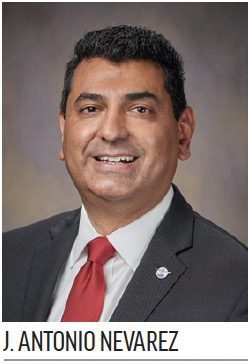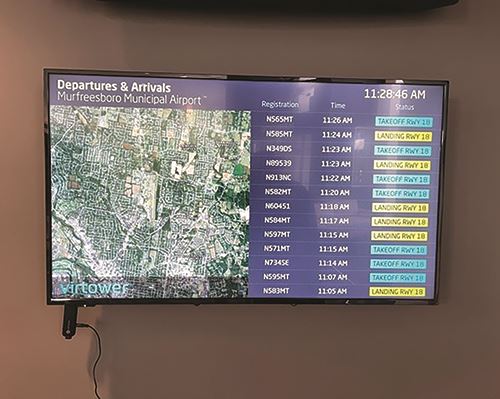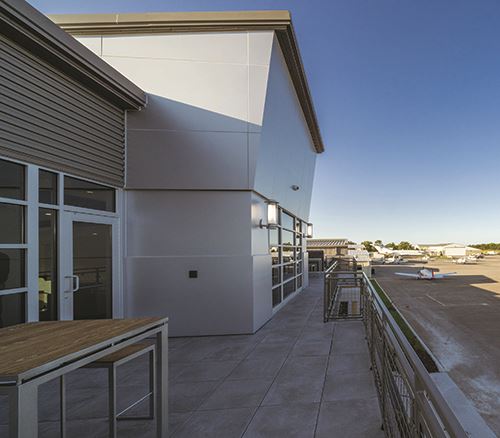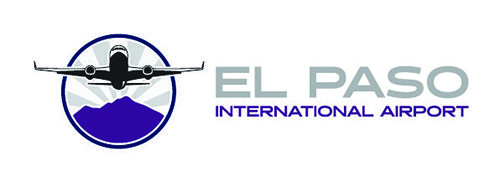For years, personnel at Murfreesboro Municipal Airport (MBT) manually tracked aircraft to estimate daily traffic at the central Tennessee airfield. Based on crude visual tallies, MBT officials began this year thinking the general aviation facility logged about 225 operations per day.
For years, personnel at Murfreesboro Municipal Airport (MBT) manually tracked aircraft to estimate daily traffic at the central Tennessee airfield. Based on crude visual tallies, MBT officials began this year thinking the general aviation facility logged about 225 operations per day.
 But with a master plan update looming next year, Airport Director Chad Gehrke wanted more definitive figures; and MBT installed an automated tracking system this past spring. The first day the new system was in service, it recorded 200 operations from 2 p.m. onward. “And on March 16, we had 683 operations, which is unbelievable for a single-runway, no-tower airport,” Gehrke remarks. “In fact, we got a call within the first day or two from the system’s president in Florida who asked, “What’s going on at your airport? The numbers are crazy! Do you have an airshow?”
But with a master plan update looming next year, Airport Director Chad Gehrke wanted more definitive figures; and MBT installed an automated tracking system this past spring. The first day the new system was in service, it recorded 200 operations from 2 p.m. onward. “And on March 16, we had 683 operations, which is unbelievable for a single-runway, no-tower airport,” Gehrke remarks. “In fact, we got a call within the first day or two from the system’s president in Florida who asked, “What’s going on at your airport? The numbers are crazy! Do you have an airshow?”
Installing the new system has been a game changer for staying on top of airfield usage, airspace management and noise abatement issues. “If I were to tell people what is happening here, they might question our figures,” says Gehrke. “But here is the hard, raw data that is being collected by a third party, which you can’t dispute.”
|
Project: Measuring/Tracking Airfield Traffic Locations: Murfreesboro (TN) Municipal Airport; El Paso (TX) Int’l Airport Method: Capture positional data from aircraft ADS-B & transponders System: VirTower Average Cost: $500/month for general aviation airports; commercial airports pay $1,000/month or more, based on their size Benefits: Data can be used to determine operational counts/limits, track receipts, assess pavement usage, address noise complaints, etc. Timeline: Both airports installed system in 2021 |
Even more importantly, accurate operational data will be pivotal when the airport begins its master layout plan in 2022. “The information is invaluable, and it’s all at a touch of a finger,” Gehrke comments. “When we did our last plan seven years ago, consultants had to do an incredible amount of work to get this data. Now, all we have to do is pull up a report.”
Increasing enrollment in the flight program at nearby Middle Tennessee State University spurred his interest in collecting better information about airfield traffic. The university bases and operates 36 training aircraft at MBT. With the student population jumping 127% in the last four years, Gehrke wanted to quantify how the uptick was affecting the airfield’s operational numbers.
Leveraging Aircraft Tech
The airport’s new VirTower system collects data about airfield traffic by using a virtual geofence to detect aircraft based on signals transmitted by their ADS-B and transponders. Now, MBT officials log onto its web-based system to receive detailed information about landings, takeoffs, taxi times, runway/taxiway usage, touch-and-go activity, FBO visitations and other aircraft movements.
“The system tracks real-time data at one-second intervals,” says VirTower President Les Goldsmith. “Airports can track aircraft activity, investigate noise complaints and generate reports on airport operations.”
The system is relatively easy to install, he notes. At MBT, the VirTower team took a half-day to map out the geofence around the airfield and ensure that signals would be accurately captured. The airport then installed a sensor box at the base connected to internet and power with two antenna at the top of a light pole that is adjacent to the terminal.
“With this system in place, if an aircraft has either ADS-B or a transponder, we can track it,” explains Goldsmith. “If it has ADS-B, that gives us the GPS position of the aircraft every second. If it only has a transponder, we use multiple sensors to triangulate the aircraft’s position every second.” Data is made available to the airport within 200 milliseconds after VirTower receives it, he adds.
 Given the volume of flight training that occurs at MBT, Gehrke is especially pleased that the system records touch-and-go traffic. Previously, it wasn’t tracked because airport personnel would have had to watch the airfield and manually count flight operations.
Given the volume of flight training that occurs at MBT, Gehrke is especially pleased that the system records touch-and-go traffic. Previously, it wasn’t tracked because airport personnel would have had to watch the airfield and manually count flight operations.
The system also documents peak traffic times and chronicles noise and congestion issues, which have spiked as traffic increased over the past few years.
“We have also been receiving complaints from pilots who were trying to come in and get out,” Gehrke says. “We started looking at what we could do. If you don’t have a tower, it’s next to impossible to count operations on a regular basis. And our traffic is not like the airlines that are consistent throughout the year. It changes from September to September with school sessions. We needed to do something to get accurate numbers.”

Commercial Applications
El Paso International Airport (ELP) in Texas uses the same system, but for different reasons. As a towered airport, ELP already had a handle on operational counts. Officials there wanted more detailed information about airfield utilization. In June, ELP began using VirTower to track traffic and ground movement, and to monitor pavement and parking issues.
 “We had been going through FAA reports to get the data, but it was very laborious; and we could not get it as fast as we wanted,” explains J. Antonio Nevarez, ELP’s assistant director of Aviation Operations and Security. “We also wanted additional data we could not get from the FIDS or the FAA, such as the type of aircraft and the runways and taxiways each aircraft used. We knew exactly how many landings and departures we had for commercial aircraft, but we didn’t have data for which runway they used, and we couldn’t pull any of that information for military or general aviation flights.”
“We had been going through FAA reports to get the data, but it was very laborious; and we could not get it as fast as we wanted,” explains J. Antonio Nevarez, ELP’s assistant director of Aviation Operations and Security. “We also wanted additional data we could not get from the FIDS or the FAA, such as the type of aircraft and the runways and taxiways each aircraft used. We knew exactly how many landings and departures we had for commercial aircraft, but we didn’t have data for which runway they used, and we couldn’t pull any of that information for military or general aviation flights.”
Better information is prompting ELP to adjust some of its plans. For instance, officials previously intended to rehabilitate one taxiway, but thought another nearby taxiway could wait. “Right away, the data told us the second taxiway was being used more in a month than what we thought it was being used in a year,” Nevarez explains. “Now, we know we must go back in there and rehabilitate and improve both taxiways.”
The new system also provides documentation when the airport bills aircraft operators for overnight parking. Previously, staff manually jotted down aircraft tail numbers. “Now, we have verification,” notes Nevarez. “We have historical proof that a certain aircraft was in El Paso for an overnight.”
Surprisingly, VirTower is helping with gate assignments for charter airlines. “We don’t have a gate management system at ELP,” says Nevarez. “Most gates are assigned, but a few are reserved for common-use. When a charter is coming in, I can now see historically what times gates are being used. This has been the first time it has been so easy to assign a gate and be confident there won’t be a conflict.”

In addition, ELP utilizes the system to monitor safety issues, such as when aircraft cross a closed taxiway. Looking ahead, ELP plans to use the system to confirm payments for fueling, landing and overnight parking that are collected by the FBO and paid to the airport. “The FBO self-reports,” explains Nevarez. “Now, we can do a general check to verify that information.”
VirTower’s Goldsmith notes that airports also use the system to support noise abatement programs. After plotting the location, date and time of a noise complaint, personnel can generate a report about the air traffic in question. Information such as aircraft type, speed and altitude can be shared with the person making the complaint, and possibly used to ensure there is not a repeat occurrence.

The sensor box was installed on a light pole adjacent to the terminal.
Costs/Benefits
General aviation airports such as MBT pay $500 per month for VirTower service. Fees for commercial airports like ELP begin at $1,000 per month and vary according to airport size.
Goldsmith says that when the system is launched, airport officials are amazed at the data they receive. The information is also valuable for airport consultants, such as David Byers, of Quadrex Aviation, who is producing a usage report to assess MBT’s airfield capacity.
 “The ability to retrieve reliable data is important,” says Byers. “You can go back and look at specific timeframes and find out who was flying where during that period. Having access to the data is incredible.”
“The ability to retrieve reliable data is important,” says Byers. “You can go back and look at specific timeframes and find out who was flying where during that period. Having access to the data is incredible.”
Being able to essentially reconstruct activity at the airport during various periods will help Byers develop a report that addresses issues such as runway queues and overall flight operations. “We’re entering an era where we have much better data on airports that traditionally did not have any objective aircraft counting going on,” he comments. “Now, I have an aircraft’s geographic position, with accurate detail, their altitude and the timestamp.”
Ultimately, the usage report may help determine the future of MBT, Gehrke says. Having pertinent data will help put the pieces of the puzzle together.
“Finding this equipment has been a blessing,” Gehrke says. “In the past when we did master plans, we had to come up with operational counts. And the best we could do is use information from Middle Tennessee State University, data from other flight schools and information from invoices because everything is based on hours. And for every hour, there’s one takeoff and one landing. But we also wanted to account for every touch-and-go. That really adds to the count.”





